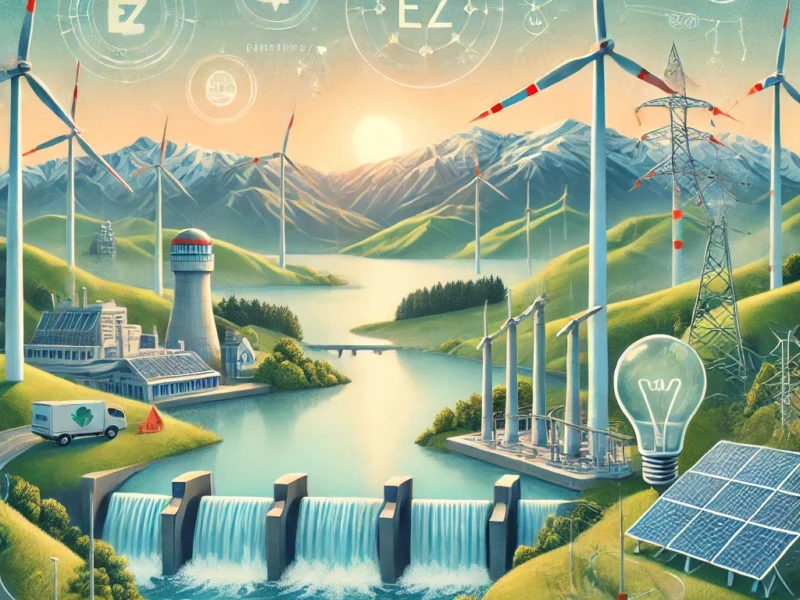As global concerns about climate change and carbon emissions intensify, New Zealand is taking significant strides toward a cleaner, more sustainable future. The country’s efforts to transition to renewable energy sources, reduce its carbon footprint, and invest in clean technology are becoming key components of its climate action plans. This transition is not just an environmental necessity but also a potential economic opportunity, as New Zealand looks to balance sustainability with growth and innovation.
In this article, we will explore New Zealand’s clean energy transition, the renewable energy sources driving this shift, the challenges and opportunities associated with it, and the government’s role in steering the country toward a green economy.
The Need for Clean Energy Transition
New Zealand has long been recognized for its stunning natural landscapes and commitment to environmental protection. However, like many nations, it faces the growing challenge of reducing greenhouse gas emissions to meet international climate commitments. As a signatory to the Paris Agreement, New Zealand has pledged to achieve net-zero carbon emissions by 2050. Achieving this goal requires a significant shift away from fossil fuels and toward renewable energy sources.
Currently, New Zealand is relatively well-positioned in terms of renewable energy. Approximately 84% of the country’s electricity already comes from renewable sources, with hydropower, wind, and geothermal energy playing prominent roles. However, to meet future energy demands and decarbonize sectors such as transportation and industry, further investment in clean energy is critical.
Renewable Energy Sources Leading the Transition
New Zealand’s renewable energy landscape is diverse, with various sources contributing to the clean energy transition:
- Hydropower: Hydropower is the largest contributor to New Zealand’s renewable energy mix, providing around 60% of the country’s electricity. The nation’s abundant rivers and lakes, particularly in the South Island, make it an ideal location for hydropower generation. While hydropower is a reliable and established source of renewable energy, there are concerns about its environmental impact on waterways and ecosystems, prompting discussions on sustainable management.
- Wind Power: Wind energy is a growing sector in New Zealand’s clean energy transition. The country’s geography, with its long coastline and vast open spaces, provides excellent conditions for wind farms. Wind power currently contributes around 6% of the country’s electricity, but its potential is far greater. Several new wind projects are in development, and experts predict that wind could play a much larger role in the future energy mix, especially as technology improves and costs continue to decrease.
- Solar Energy: While solar power has traditionally played a smaller role in New Zealand’s energy production, it is rapidly gaining momentum. Advances in solar technology, along with falling costs, have made solar panels more accessible for households and businesses. Solar energy is particularly well-suited to decentralized, small-scale applications such as rooftop solar installations. As more New Zealanders adopt solar power for personal use, it is expected to become a more significant contributor to the nation’s renewable energy portfolio.
- Geothermal Energy: New Zealand is one of the few countries with substantial geothermal energy resources. The country’s geothermal fields, particularly in the Taupō Volcanic Zone, provide a stable and consistent source of electricity. Geothermal power plants currently generate about 17% of New Zealand’s electricity, and there is potential for further development in this area. Geothermal energy has the advantage of being a reliable, base-load power source, unlike more intermittent renewable sources like wind and solar.
Government Initiatives and Investments
The New Zealand government has recognized the urgency of accelerating the transition to renewable energy and has introduced various initiatives to support this effort. Some of the key policies and investments include:
- Zero Carbon Act: Passed in 2019, the Zero Carbon Act sets the legal framework for New Zealand to achieve net-zero carbon emissions by 2050. It includes measures to reduce emissions across all sectors of the economy, including energy, transport, and agriculture. The act also established the Climate Change Commission, an independent body tasked with advising the government on emissions reduction pathways and progress.
- Energy Strategy: The New Zealand government is currently developing a comprehensive energy strategy that will outline the country’s approach to achieving a 100% renewable electricity system by 2030. This strategy focuses on expanding renewable energy generation, improving energy efficiency, and transitioning to low-emission technologies.
- Clean Energy Investment Fund: In recent years, the government has committed substantial funding to support renewable energy projects and the development of clean technology. The Clean Energy Investment Fund aims to attract private investment into renewable energy, energy storage solutions, and electric vehicle infrastructure. This public-private partnership model is crucial for scaling up renewable energy capacity and fostering innovation in the green economy.
- Electric Vehicle Incentives: One of the key challenges in reducing New Zealand’s carbon emissions lies in the transportation sector, which remains heavily reliant on fossil fuels. To address this, the government has introduced incentives for electric vehicles (EVs), including rebates, subsidies, and tax breaks. The adoption of EVs is a vital step toward decarbonizing transport, and the government’s goal is to achieve widespread EV use by 2035.
- Just Transition: Recognizing that the shift to a green economy will have social and economic impacts, the New Zealand government has adopted a “Just Transition” approach. This ensures that workers and communities reliant on fossil fuel industries are supported in the transition to renewable energy. The government is providing training, education, and financial support to help workers transition into new, sustainable jobs.
Challenges and Opportunities
While New Zealand has made significant progress in its clean energy transition, several challenges remain. These include:
- Balancing Environmental Impact: While renewable energy sources are essential for reducing carbon emissions, they are not without environmental impacts. For example, large hydropower projects can disrupt ecosystems, while wind farms may affect bird populations and landscapes. As New Zealand expands its renewable energy capacity, it will be crucial to carefully balance environmental sustainability with energy production.
- Energy Storage and Grid Infrastructure: As renewable energy sources like wind and solar become more prominent, there will be a growing need for energy storage solutions and grid infrastructure upgrades. Renewable energy can be intermittent, depending on weather conditions, so ensuring a stable and reliable energy supply requires investments in battery storage and smart grid technology.
- Economic Growth and Innovation: The transition to clean energy presents significant economic opportunities for New Zealand. The development of a green economy can create jobs, stimulate innovation, and position the country as a leader in renewable technology. By investing in research and development, New Zealand can not only meet its climate goals but also enhance its economic competitiveness on the global stage.
- Public Engagement and Behavior Change: Achieving a successful clean energy transition will also require public engagement and behavior change. Encouraging energy efficiency, reducing waste, and promoting sustainable lifestyles are all part of the broader effort to reduce carbon emissions. Educational campaigns and incentives can help foster a culture of sustainability among New Zealanders.
The Path Forward
New Zealand’s clean energy transition is a vital component of its efforts to address climate change and build a sustainable future. With its abundant renewable energy resources, innovative policies, and growing investments in clean technology, the country is well-positioned to achieve its ambitious climate goals. However, the road ahead will require continued commitment from the government, businesses, and individuals alike.
By embracing renewable energy and investing in the green economy, New Zealand can not only protect its natural environment but also ensure long-term economic prosperity. As the world faces the challenges of climate change, New Zealand’s leadership in clean energy provides a model for other nations striving to create a sustainable and resilient future.
As New Zealand moves forward with its clean energy transition, it’s essential to consider the broader economic context, including the ongoing cost of living crisis. Many New Zealanders are facing financial challenges due to rising costs, which may influence the adoption of renewable energy solutions. For a deeper understanding of the current economic landscape, explore more in this article on the Cost of Living Crisis in New Zealand.


